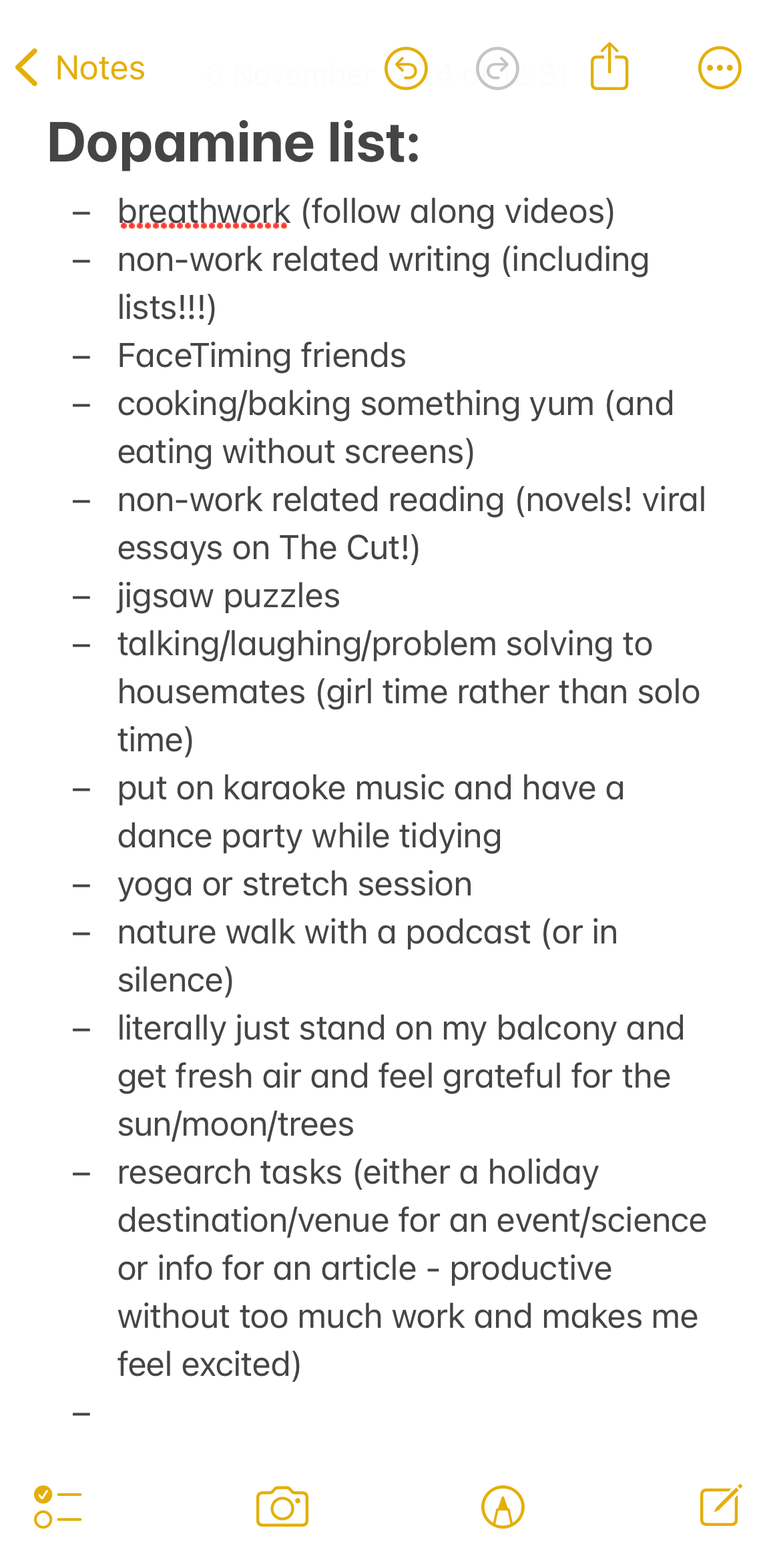
Dopamine menus are the latest TikTok wellness trend for improving your mood and mindset. Joining the likes of Sunday reset routines and the 5-4-3-2-1 technique, dopamine menus are all gentle and enjoyable ways to look after your mental health.
And according to the stats, we all need it. 91% of UK adults experienced high or extreme levels of pressure or stress in the past year, according to Mental Health UK’s Burnout report last year.
Our habits don't help. Over 50% of individuals in the UK admit to being addicted to scrolling, found Lenstore, while many people turn to drinking, smoking or other unhealthy habits to deal with stress.
Truth be told? I'm a Health Editor, but I get it. When I'm stressed, I tend to feel paralysed, which results in me doing anything except the useful habits that I know will help to beat the stress. "When people feel down, motivation tends to drop, and it is easy to feel overwhelmed or unsure of what might help," explains Dr Madeleine Jago, principal clinical psychologist and co-founder of Seven Lion Yard.
She thinks that the dopamine list trend could be a great way to boost mood in those moments. "Having a list provides concrete, accessible options that act as a gentle reminder of coping strategies," says Dr Jago.
Below, read how I got on testing out the viral dopamine list trend, while Dr Jago explains more about what dopamine is and how it can help our mood. For more mental wellness hacks, check out our guides to low dopamine mornings and dopamine fasting, here.
Dopamine menus are trending - so I tried one myself
What is the dopamine menu trend?
Before we dig into the dopamine menu trend, we first need to dig into dopamine itself.
"Dopamine is a neurotransmitter that plays a crucial role in the brain’s reward and pleasure systems, as well as in regulating mood, motivation, and focus. It is often described as a feel-good chemical because it is released in response to rewarding activities, creating a sense of enjoyment and satisfaction," explains Dr Jago.
"In essence, dopamine helps reinforce behaviours by making us want to repeat pleasurable or beneficial activities. When dopamine levels increase, we can feel more motivated, alert, and satisfied, which is why boosting dopamine can feel so rewarding," she goes on.
However, you can get dopamine that doesn't feel quite so good. "Excessive or artificial boosts, like those from addictive substances or behaviours, can lead to unhealthy patterns where we chase that feeling at the expense of balance and wellbeing," she says. That might include behaviours such as scrolling, shopping, drinking alcohol or eating less nutritious foods.
Luckily, the dopamine menu is designed to avoid those short bursts of dopamine. The idea is that you create a list - in your phone notes app, on an accessible piece of paper or in your head - of all the things that make you feel good — really good, in the long term. When you're feeling down, stressed or tempted to turn to a short-term source of dopamine, you instead turn to your list and do one of the more positive actions.
"A list of feel-good activities can be a powerful tool for self-care, especially when people feel lower in mood. It can also make it easier to take positive action rather than default to passive or unhelpful behaviours, like avoidance or rumination.
"This list can help people focus on activities that are constructive and nurturing, rather than actions that might compound their low mood. Over time, using this list can also strengthen positive habits, giving the individual an increasingly reliable set of resources to rely on," says Dr Jago.
@victoriaharderxo ♬ original sound - victoria ✿ habits + daily life
What should be on a dopamine menu?
"Many everyday activities can naturally increase dopamine levels, especially those that are mentally or physically engaging, rewarding, or fulfilling. Each person’s dopamine-boosting activities will vary depending on what they find personally rewarding so people should create their own unique list to draw from," says Dr Jago.
She'd include activities like these a dopamine menu:
1. Physical exercise
"Any form of movement, from running and weightlifting to yoga, boosts dopamine and other feel-good chemicals like endorphins," says Dr Jago.
In a trial that examined both 'voluntary' exercise (in which the participants cycled) and involuntary exercises (using electrical muscle stimulation), only voluntary exercise led to a noticeable increase in dopamine release. Those who increased their dopamine with exercise also had other cognitive benefits post-exercise, such as better reaction times, according to The University of Portsmouth.
2. Listening to music
"Engaging with music we love can increase dopamine and often lifts our mood," says Dr Jago. This was confirmed in a 2019 study that found people who had been given dopamine enhancers got more pleasure from music than those who took dopamine blockers.
"It is important to highlight that we were not looking for a magic pill able to increase the feelings of pleasure while listening to music […] What we can say is much more interesting: listening to the music you love will make your brain release more dopamine, a crucial neurotransmitter for humans’ emotional and cognitive functioning," researchers told PsyPost.
3. Creative pursuits
"Activities like painting, writing, or playing an instrument can be intrinsically rewarding," notes Dr Jago.
Research suggests that we typically get more dopamine from tasks we want to do, so don't force yourself into a creative pursuit that you find dull. Instead, work out what types of creativity you enjoy — you'll feel better for it.
@aleks_jevtic ♬ original sound - aleks_jevtic
4. Mindfulness, meditation and breathwork practices
"Meditation, deep breathing, and mindful activities encourage dopamine release over time and promote relaxation," says Dr Jago.
A study from the Human Brain Mapping journal found regular meditators had increased dopamine "tone". This means their background levels of dopamine activity were greater, suggesting a more reactive dopamine response to tasks.
It can also have an immediate effect. A study published in Cognitive Brain Research found a 65% increase in dopamine release during Yoga Nidra meditation.
5. Learning new skills
"Setting and achieving small learning goals can give a strong dopamine boost," says Dr Jago.
These small goals could be hitting a certain amount of words in an essay or making your bed in the morning. The most important thing is to take time to notice and celebrate theme as achievements, encouraging dopamine release.
6. Social connection
"Spending time with loved ones or engaging in meaningful conversations helps release dopamine and other mood-regulating chemicals," says Dr Jago.
Successful social interactions have been shown to be some of the most powerfully rewarding stimului for human beings. That's not just because being with a community feels nice, but also because it involves navigating complex situations, emotions and hierarchies, all leading to a sense of achievement.
@happyolivestudio ♬ EP 157 note to self by payton sartain podcast - Payton Sartain
I tried a dopamine menu — it saved me from doomscrolling
Fed up of subconsciously reaching for my phone and losing entire evenings when I feel low, bored or under-stimulated, I decided to give the dopamine menu trend a try.
I picked a week when I was home alone as it would mean my usual pick-me-up (my housemates) weren't there to offer me my usual healthy dopamine boost.
Day one
Day one had to begin with writing the dopamine menu list. I will admit: it's hard to sit down and remember everything that makes you feel good. I'd recommend adding things as and when you do them and notice yourself feeling accomplished.
As Dr Jago said, a dopamine menu should be comprised of smaller, achievable goals. Yes, I get a huge sense of satisfaction - and release of dopamine - when I hand in a big project. But that's not an easy or achievable task I can do in moments of sadness.
Instead, I added things to my list that I could realistically do in time slots of between five minutes to a couple of hours, designed for moments in my day that I might be feeling unmotivated, stressed or sad.

Day two
After a productive day, I found myself running out of steam at around 5pm. I knew I didn't want to spend the rest of the evening sat on my sofa scrolling or watching re-runs of comfort TV, so I turned to my list.
The thing that felt most appealing on this day was research for an upcoming trip. I set myself the goal: figure out the cheapest way to fly to the holiday destination my friends and I are booking.
I spent half an hour investigating flights and, feeling motivated, continued the streak by also researching nearby islands, hotels and things to do. Overall, a success. It felt good too — rather than feeling grubby and knackered from comparison as I do after coming off my phone, I felt quietly accomplished.
Day three
I had been out all day so, upon returning to an empty house, I was ready to collapse on the sofa until bed time. At the start of the day, I'd told myself to do a run, but that felt unachievable in the cold and dark. Instead, I compromised: a short walk to the shop.
I turned on a podcast, walked the long way to the shop and definitely felt more energised. Then I spent some time cooking, focusing solely on the ingredients and sizzling pan in front of me instead of multitasking with work or social media.
It's no surprise that I felt better doing that than bed rotting for the evening.
Days four and five
I don't know what changed but I felt very unmotivated upon waking up for the next couple of days. It was the type of days where you would do anything to avoid getting through your to-do list.
After a few hours of proscrastination, I thought enough was enough. If I wasn't going to do work, I reasoned I had to do something that made me feel good. So I turned on the radio and tidied.
I love using music as a motivator for tasks like cleaning, running and getting ready. And it worked on these days: the clothes that had piled on my desk chair made their way back to my wardrobe. It might have been the sense of achievement or the now-tidy desk space but, either way, I managed to concentrate on the work I had to do too.
The next day, I decided to exercise instead. I took myself on a gentle run that I definitely didn't want to do but felt good after. After a shower and lunch, I felt so focused and good about myself that my work tasks no longer felt so mammoth.

Days six and seven
It's easy for me to do nothing or get lost in boring work over the weekend — both extreme ends of the scales that never leave me feeling great. This weekend, I decided to switch it up by doing tasks on my list.
First up was yoga. I love yoga but it's not something I'm great at prioritising yet, perhaps unshockingly, it always leaves me with a soothing sense of happiness.
Over the weekend, I also FaceTimed a friend I hadn't seen in a while and had a real catch up, rather than just commenting on her Instagram pics. I also put my phone in another room and read my book, which always leaves me feeling stimulated rather than sad.
I'd say I ended the week feeling much better and more motivated ahead of the week to come than if I'd sat doomscrolling. It's not so much that these activities were new or stress beating but that I had a handy list on my phone so my brain had access to alternatives.
Overall, I'd recommend a dopamine menu for that specific reason: when you're feeling low or unenergised, it can seem impossible to come up with ways to boost your mood, hence why we mindlessly doomscroll. Having a list makes it much more achievable and left me feeling better set to get on with other tasks that also boosted dopamine, like positive dominos.
Shop MC UK's go-to wellness producs now:
If boosting dopamine is about completing tasks then you need to get your hands on this planner. With space for note-making as well as daily to-do lists and time blocking, it's perfect for beating every type of procrastination.







